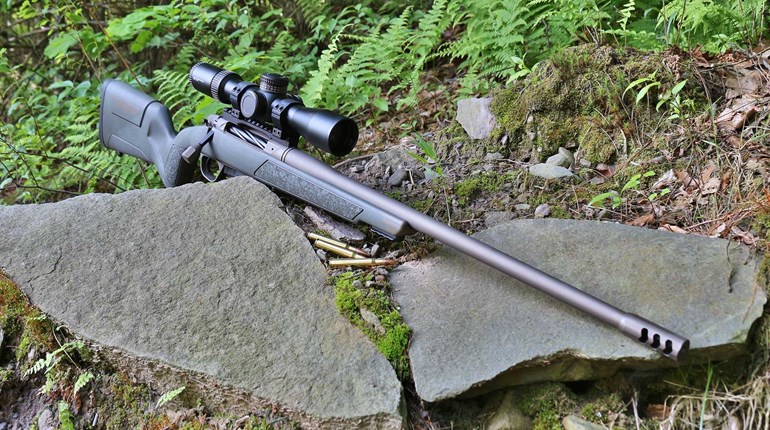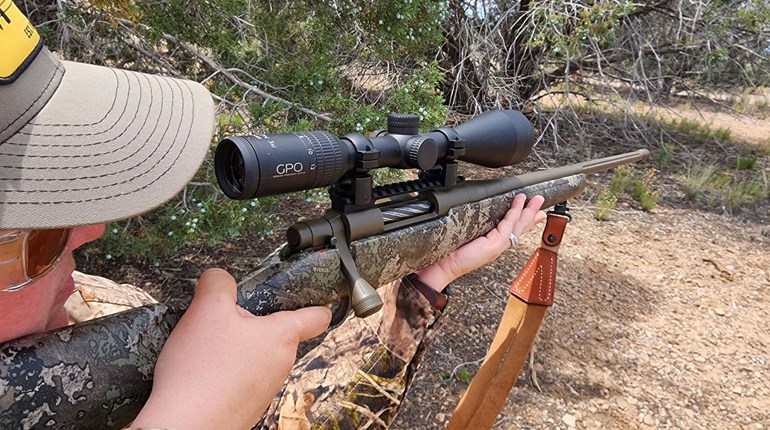
I found myself in quite a situation last October in Oklahoma. As an uncontrollable virus staggered its way around the globe, and as I prepared to board a plane in Virginia, weather alerts for Oklahoma City (OKC), my destination for a whitetail muzzleloader hunt, looked shocking. Little did I know that by the time I would land the weather would worsen, and I would find myself in the midst of a rare and historic ice storm. I was used to such storms in Virginia, but I grew more concerned with every passing hour that this hunt would end up far from successful.

Mother Nature continued her fury on the drive from OKC to Elk City. The closer we got, the slower we were forced to drive, but we eventually made it to the lodge at Rut N Strut Guide Service. The weather worsened as the day progressed into night, and the week's forecast didn't look much better. In addition to the current freeze, another obstacle that took some serious consideration was coming: after two days, temperatures were scheduled to rise into the 80s.
The forecast weighed heavy on my mind, but at that point I just wanted to hunt and forget about the details, and I wasn’t alone in my thinking. So we confirmed our rifles’ abilities on the target range and readied our gear for the morning.
All hope for late-week success dwindled the further I cross-referenced the forecasts and stared at the rising full moon. It was obvious the best days to find a good buck on this hunt were while the land glowed like alabaster.
I’d hunted primitive arms season in Oklahoma before with a muzzleloader, but the gun I had with me this time around was not an ordinary muzzleloader.

If you’re familiar with muzzleloading rifles, you’ll understand me when I say they’re needy. Those who love them, love them, and always will. There is an alluring facet to the designs, a nostalgia, if you will, and functionality that captivates me—not to mention I’ve found their use to be advantageous to good hunting during seasons set aside exclusively for their use. But they require work and accoutrements, which can be off-putting, especially to new enthusiasts.
So what if I told you Traditions Firearms and Federal Premium came up with a solution that streamlines the shooting process of a gun that loads from the muzzle? That’s right. These two companies turned everything we once knew about muzzleloading upside down with the Traditions NitroFire—a firearm in which you load the bullet first then add the FireStick charge from the rear. The design of the rifle and the charge it uses are revolutionary, so much so that the current ATF classification requires purchasers of a NitroFire to file a Form 4473 with a registered firearm dealer.
The sad reality is that many states have disregarded the NitroFire as an acceptable gun for use within dedicated muzzleloader seasons due to this ruling. But unlike my home state of Virginia, Oklahoma is not one of them. That fact set the stage for our deer hunt in the ice storm.
The Hunt
The next morning, we ventured out the door of the lodge at zero-dark-thirty and onto a glacier of ice several inches thick. The accumulations overnight were tremendous, and the conditions created a dreary day for deer hunting.
The drive to the blind was trouble-free. But after dropping off another hunter I found my blind absolutely covered in ice. I felt like a vandal attempting a mouse-like break-in. Every sheet of ice hit the ground with an explosive-like sound that I thought was sure to spook every deer in the county. The three minutes it took to get settled felt like an eternity. But finally the moment I had waited for arrived: shooting light!
Does began to trickle toward the feeder, and as I watched them I thought of the variables stacked against me, and an old hunter's adage looped through my mind: A deer you would shoot on the last day of a hunt is a deer you should shoot on the first day.
Then he appeared. What looked to be a beautiful mainframe 8-point with a branching tine off both left and right G2’s was making his way directly to me. I’d experienced this moment dozens upon dozens of times before this day, but it still took me by surprise. In fact, I was so distracted by a small group of does 200 yards to my right that when I saw the buck I simply forgot to charge the NitroFire.
Now, with the muzzle projecting from the small, frozen window of the icebox hut, I opened the action and fed the breech a freshly primed FireStick. The moment I closed the action, the double-kicker buck at the feeder about 45 yards away from me threw up his head. I thought to myself: He’s going to dart, I know it. Instead, the buck began to display some aggression, and at that moment a young spike pushed into his comfort zone.

With the hammer back, I reached for the cross-bolt safety and told myself, This is the one. The buck was close and in constant motion, and a threatening young lad was in his vicinity, so I let out a light bleat from my throat as I quietly snapped off the safety. The buck slightly quartered and stopped, curiously attentive to my near-perfect tone. This was the moment I'd dreamt of: an Oklahoma whitetail in perfect range with gun to my shoulder and forearm solidly rested. I slowly squeezed the single-stage trigger as I held just forward of his left shoulder.
I watched the buck fall less than a hundred yards away, but I pushed another bullet down the pipe and charged the breech in mere seconds anyway, anticipating a worst-case scenario. I held the scope’s crosshair on the bunch of sage into which the buck crashed, and as the minutes stacked up so did my impatience. I had just made what appeared to be a perfect heart/lung shot—I wanted to put my hands on a beautiful Oklahoma-bred buck.

I’ve hunted with muzzleloaders my entire adult life, and I’ve never used a gun like the NitroFire. It’s so incredibly simple; it made the hunt almost too good to be true. Even my shaky-hand reload could not accidentally spill powder or forget to add three pellets instead of two. The sealed Federal FireSticks charged with Hodgdon Triple Eight blackpowder substitute provided extra assurance amid the humidity and icy environment. Luckily, I did not have to fire another round; the buck was down for good. Once the guide arrived, all I had to do to make the gun safe for transport was remove the FireStick and climb from the blind.
Sunny Skies
The Oklahoma Ice Storm of 2020 lingered for a few days, leaving many folks without power, including our lodge for most of the week. But soon after the ice blast, daytime temperatures skyrocketed, turning the glacial mass to slick red mud. As the heat wave continued, it became apparent that the deer transitioned to their full-moon, night-active patterns, which didn’t make for great hunting. The remainder of hunters in camp hunted hard each day in the blazing heat, but none of them noticed much deer activity during daylight hours. As they hunted for deer the remainder of the week, I focused my attention on the numerous coyotes in the area.
I was happy my plan came together, even if my deer hunt was over in 20 minutes. The equipment I used performed better than I anticipated, and provided me a trophy story to tell Mom. Sometimes it pays to take the first shot opportunity when the odds are stacked unfavorably.
Traditions NitroFire & Federal Premium FireStick
A joint effort between Traditions Firearms, Hodgdon and Federal Premium produced a new muzzleloading system that is so wildly different from any design before it, the ATF deemed the rifle a firearm, thus requiring approval of a background check and federal Form 4473 filing for all purchases. The rifle is called the NitroFire, and the charge it fires is called the FireStick. Combined, the tandem is American Hunter’s 2021 Muzzleloading Product of the Year.

The Traditions NitroFire rifle I used in Oklahoma included a 26-inch barrel and a Traditions 3X-9X-40mm riflescope. At first glance its design may appear complicated but I assure you it is not.

Within Federal Premium’s FireStick is Hodgdon’s new Triple Eight black powder substitute that is temperature-controlled and sealed to inhibit moisture absorption. FireSticks come in 100- and 120-grain charges, and Federal color-codes them to easily differentiate between the two. The powder within the polymer capsule is loose, not compressed. The charges are molded for No. 209 shotshell primers, which the hunter inserts before firing.
Very little fouling occurred from either charge weights between shots as compared to black powder and its substitutes. Also, very little smoke is emitted from each shot—you can maintain eye contact with your target even after the shot.

The trigger is Traditions’ Elite XT, an upgrade over previous designs. A rebounding hammer assembly provides added safety in the event the rifle is dropped or smashed against a solid object to prevent the hammer from contacting the striker housed within the alloy receiver, unless the trigger mechanism is physically engaged rearward. Additionally, there is a cross-bolt safety at the rear of the trigger guard; press it to the left, and a red dot is exposed signifying the rifle’s condition of readiness.
Forward of the trigger guard is the hinge-action’s barrel catch lever; squeeze the lever rearward to break open the action. Upon opening, the gun’s extractor is activated, dropping free of the breech and advancing a spent charge capsule rearward for easy removal. Full disclosure: Twice during testing, the FireStick crimp sheared and became wedged behind the seating ring machined within the barrel just forward of the chamber, but an accessory kit included with the gun contains a breech brush, which I used to remove the stuck plastic ring.
The gun’s stock, made of black polymer, features a raised cheekpiece, two sling studs and a butt capped with a generous recoil pad. Checkering molded into the fore-end and wrist contributed to a sure grip in icy Oklahoma.
A solid-aluminum ramrod is included for seating bullets in the bore, in addition to the supplied Quick-T ramrod handle. The chrome-moly steel fluted and tapered barrel is coated with a Cerakote finish to inhibit corrosion. The twist rate of the rifling is 1:28-inch, which is common and effective.
The Traditions NitroFire and Federal FireStick system creates one of the most innovative firearm designs I’ve encountered in recent years. And it is my hope that more states will allow use of the system during dedicated primitive arms seasons.




































